| |
Intermediate Algebra
Tutorial 32:
Multiplying and Dividing
Rational
Functions
 Learning Objectives Learning Objectives
|
After completing this tutorial, you should be able to:
-
Find the domain of a rational function.
-
Simplify a rational expression.
-
Multiply and divide rational expressions.
|
 Introduction Introduction
|
| Do
you ever feel like running and hiding when you see a fraction? If
so, you are not alone. But don't fear! Help is here!
Hey, that rhymes. Anyway, over the next several tutorials we will
be showing you several aspects of rational expressions
(fractions).
In this section we will be simplifying them. Again, we will be
putting
your knowledge of factoring to the test. Factoring plays a big
part
of simplifying these rational expressions. We will also look at
multiplying
and dividing them. I think you are ready to tackle these rational
expressions. |
 Tutorial Tutorial
|
|
Rational
Expression or Function
A rational
expression or function
is one that can be written in the form

where P and Q
are polynomials
and Q does not equal 0.
|
| An example of a rational expression is :

|
|
Domain of
a Rational Function
|
| Recall from Tutorial
13:
Introduction to Functions that the domain of a function is the
set of all input values to which the rule applies.
With rational functions, we
need to watch out
for values that cause our denominator to be 0. If our
denominator is 0, then we have an undefined value.
So, when looking for the domain of a given rational
function, we use
a back door approach. We find the values that we cannot use,
which
would be values that make the denominator 0.
|
 Example
1: Find the domain of the function Example
1: Find the domain of the function  . . |
| Our restriction is that the denominator of a fraction
can never be
equal to 0.
So to find our domain, we want to set the denominator
“not equal” to
0 to restrict those values.
|
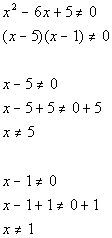 |
*Restrict values that cause
den. to be 0
*"Solve" for x
*"Solve" for x
|
| Our domain is all real numbers except 5 and 1
because they both
make the denominator equal to 0, which would not give us a real number
answer for our function. |
Fundamental
Principle of
Rational
Expressions
For any
rational expression  ,
and any polynomial R, where , ,
and any polynomial R, where , ,
then ,
then

|
| In other words, if you multiply the EXACT SAME thing
to the numerator
and denominator, then you have an equivalent rational expression.
This will come in handy when we simplify rational
expressions, which
is coming up next.
|
Simplifying
(or reducing)
a
Rational Expression
|
| Step 1: Factor the numerator and the
denominator. |
| If you need a review on factoring, you can go to any or
all of the
following tutorials:
|
| Step 2: Divide out all common
factors that the numerator
and the denominator have. |
 Example
2: Write the rational expression in lowest terms Example
2: Write the rational expression in lowest terms  . . |
| Step 1: Factor the numerator and the
denominator
AND
|
| Step 2: Divide out all common
factors that the numerator
and the denominator have. |
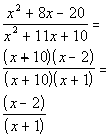 |
*Factor the num. and den.
*Divide out the common factor
of (x
+ 10)
|
|
Multiplying
Rational Expressions

Q and S do not equal 0.
|
| Step 1: Factor both the numerator
and the denominator. |
| If you need a review on factoring, you can go to any or
all of the
following tutorials:
|
| Step 2: Write as one fraction. |
| Write it as a product of the factors of the numerators
over the product
of the factors of the denominators. DO NOT multiply anything out
at this point. |
| Step 3: Simplify
the rational
expression. |
 Example
3: Multiply Example
3: Multiply  . . |
| Step 1: Factor both the numerator
and the denominator
AND
|
| Step 2: Write as one fraction. |
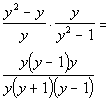 |
*Factor the num. and den.
|
| Step 3: Simplify
the rational
expression. |
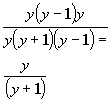 |
*Divide out the common factors
of y
and (y - 1)
|
|
Dividing
Rational Expressions

where Q, S, and R do not equal 0.
|
| Step 1: Write as multiplication of
the reciprocal.
Step 2: Multiply
the rational expressions
as shown above.
|
 Example
4: Divide Example
4: Divide  . . |
| Step 1: Write as multiplication of
the reciprocal
AND
Step 2: Multiply
the rational expressions
as shown above.
|
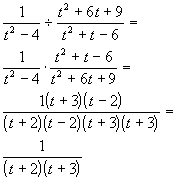 |
*Rewrite as mult. of reciprocal
*Factor the num. and den.
*Div. out the common factors
of
(t +
3) and (t
-
2)
|
 Example
5: Multiply and divide Example
5: Multiply and divide  . . |
| Since we have a division, let’s go ahead and rewrite
that part of it
as multiplication of the reciprocal and proceed with multiplying the
whole
expression: |
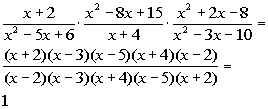 |
*Rewrite the division as mult.
of recip.
*Factor the num. and den.
*All factors divide out
|
| Be careful. 0 is not our answer here. When
everything divides
out like this, it doesn’t mean nothing is left, there is still a 1
there. |
 Practice Problems Practice Problems
|
| These are practice problems to help bring you to the
next level.
It will allow you to check and see if you have an understanding of
these
types of problems. Math works just like
anything
else, if you want to get good at it, then you need to practice
it.
Even the best athletes and musicians had help along the way and lots of
practice, practice, practice, to get good at their sport or instrument.
In fact there is no such thing as too much practice.
To get the most out of these, you should work the
problem out on
your own and then check your answer by clicking on the link for the
answer/discussion
for that problem. At the link you will find the answer
as well as any steps that went into finding that answer.
|
 Practice
Problem 1a: Practice
Problem 1a:
Find the domain of the rational
function.
|
1a. 
(answer/discussion
to 1a) |
 Practice
Problems 2a - 2c: Practice
Problems 2a - 2c:
Multiply or divide.
|
2a. 
(answer/discussion
to 2a) |
2b. 
(answer/discussion
to 2b) |
2c. 
(answer/discussion
to 2c) |
 Need Extra Help on These Topics? Need Extra Help on These Topics?
|
No appropriate web pages could be found to help you
with the topics
on this page.
for
some
more suggestions.
|
All contents
Jan. 8, 2002 |
 Example
1: Find the domain of the function
Example
1: Find the domain of the function 




